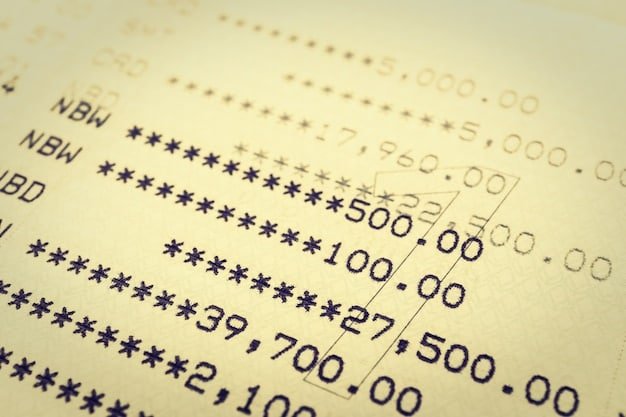Rebuild Your Credit After Debt Settlement: A Practical Guide for 2025

Rebuilding credit after debt settlement involves establishing positive payment history, managing credit utilization, and potentially using secured credit options to demonstrate responsible financial behavior to lenders.
Settling your debts can provide a fresh start, but rebuilding your credit afterward is crucial for long-term financial health. This guide offers practical steps on how to rebuild your credit after debt settlement, ensuring you’re prepared for future financial opportunities.
Understanding the Impact of Debt Settlement on Your Credit
Debt settlement can significantly impact your credit score. It’s important to understand the extent of this impact and how it affects your ability to access credit in the future.
Debt settlement involves negotiating with creditors to pay a reduced amount of what you owe. While this can relieve immediate financial stress, it negatively affects your credit report. Let’s explore how this process influences your creditworthiness and the steps you can take to mitigate the damage.
How Debt Settlement Affects Your Credit Score
Debt settlement typically appears on your credit report as “settled” or “partially paid,” which is viewed less favorably than accounts paid in full. This can lower your credit score and make it harder to obtain new credit.
The Long-Term Implications of a Lower Credit Score
A lower credit score can affect various aspects of your life, including your ability to get approved for loans, rent an apartment, or even secure certain employment opportunities. Rebuilding your credit is vital to regain financial stability and access better terms on future credit products.

Here are some practical steps you can take:
- Monitor Your Credit Report: Regularly check your credit report to ensure accuracy and identify any errors that may be affecting your score.
- Understand Credit Scoring Models: Familiarize yourself with how credit scores are calculated to better understand what factors influence your score.
- Prepare for Potential Scrutiny: Be prepared to explain the circumstances of your debt settlement to potential lenders when applying for credit.
Understanding the immediate and long-term effects of debt settlement on your credit is the first step towards rebuilding. Knowing what to expect allows you to strategically approach credit repair and make informed decisions about your financial future.
Establishing Positive Payment History
Establishing a positive payment history is one of the most effective ways to improve your credit score. Consistent, on-time payments demonstrate to lenders that you are a responsible borrower.
After debt settlement, creating a track record of timely payments is critical. Your payment history is a significant factor in determining your credit score, making it essential to prioritize and maintain a consistent payment schedule. Here are strategies to help establish and maintain a positive payment history.
Secured Credit Cards
Secured credit cards require a cash deposit as collateral, making them easier to obtain if you have a damaged credit history. Using a secured card responsibly can help you rebuild credit.
Credit-Builder Loans
Credit-builder loans are designed to help individuals with little or no credit history establish credit. These loans typically involve making fixed payments over a set period, with the funds being released to you at the end of the term.
Building a positive payment history is a gradual process that requires discipline and consistency. By using these tools and strategies effectively, you can demonstrate your creditworthiness to lenders and steadily improve your credit score.

- Set Up Payment Reminders: Use reminders on your phone or email to ensure you never miss a payment.
- Automate Payments: Set up automatic payments from your bank account to guarantee timely payments.
- Choose Manageable Credit Lines: Start with smaller credit lines that you can easily manage and pay off each month.
By prioritizing timely payments and using credit responsibly, you can rebuild your credit and demonstrate financial responsibility to lenders.
Managing Credit Utilization
Credit utilization, the amount of credit you’re using compared to your total available credit, is a crucial factor in your credit score. Keeping your credit utilization low can significantly improve your creditworthiness.
Maintaining a low credit utilization ratio is essential because it indicates to lenders that you are managing your credit responsibly. This ratio is calculated by dividing the amount of credit you’re using by your total available credit. Aim to keep this below 30% to signal responsible credit behavior. Let’s dive into how you can effectively manage your credit utilization to boost your credit score.
Understanding the Ideal Credit Utilization Ratio
Ideally, you should aim to keep your credit utilization below 30%. For example, if you have a credit card with a $1,000 limit, try to keep your balance below $300.
Strategies for Lowering Credit Utilization
Lowering your credit utilization can be achieved through various strategies. One approach is to make multiple payments throughout the month to keep your balances low. Another strategy is to increase your credit limits without increasing your spending.
Managing credit utilization is an ongoing process that requires diligence and mindful spending habits. Maintaining a low credit utilization ratio not only improves your credit score but also reduces your reliance on credit and promotes healthier financial behavior.
- Monitor Your Spending: Track your credit card balances and spending habits to stay within your target credit utilization range.
- Request Credit Limit Increases: Contact your credit card issuers to request higher credit limits, which can lower your credit utilization ratio.
- Pay Down Balances Regularly: Make extra payments throughout the month to keep your balances low.
By diligently managing your credit utilization and making informed decisions about your credit usage, you can improve your credit score and demonstrate financial responsibility to lenders.
Exploring Secured Credit Options
Secured credit options, such as secured credit cards and secured loans, can be valuable tools for rebuilding credit after debt settlement. These options require collateral but offer a pathway to establishing or re-establishing credit.
Secured credit cards and loans serve as stepping stones for individuals aiming to rebuild their credit. The collateral provides security to the lender, reducing their risk and making it easier for you to get approved. Here’s how you can leverage these tools effectively:
How Secured Credit Cards Work
Secured credit cards require a cash deposit that typically serves as your credit limit. By making timely payments, you can demonstrate responsible credit behavior and improve your credit score.
The Benefits of Secured Loans
Secured loans involve pledging an asset, such as a vehicle or savings account, as collateral. These loans can help you build credit while financing a necessary purchase.
Secured credit options provide a structured and controlled environment for rebuilding credit. By using these tools responsibly and making timely payments, you can steadily improve your credit score and gain access to more conventional credit products in the future.
- Research Different Secured Credit Cards: Compare interest rates, fees, and reporting practices to find the best option for your needs.
- Understand the Terms of Secured Loans: Review the loan agreement carefully, paying attention to interest rates, repayment terms, and any associated fees.
- Use Secured Credit Wisely: Avoid maxing out your credit limit and make timely payments each month to maximize the benefits to your credit score.
By carefully exploring and using secured credit options, you can take proactive steps toward rebuilding your credit and improving your financial outlook.
Budgeting and Financial Planning
Effective budgeting and financial planning are essential components of rebuilding credit after debt settlement. Creating a budget helps you manage your finances, prioritize debt repayment, and avoid future financial setbacks.
One of the cornerstones of successful credit rebuilding is establishing a solid financial plan. Budgeting allows you to track your income and expenses, set financial goals, and make informed decisions about your spending. Let’s explore the importance of budgeting and financial planning in the credit repair journey.
Creating a Realistic Budget
Start by tracking your income and expenses to understand where your money is going. Use budgeting tools or apps to monitor your spending and identify areas where you can cut back.
Setting Financial Goals
Setting achievable financial goals, such as paying off debt or saving for a down payment, can provide motivation and direction as you rebuild your credit.
Budgeting and financial planning are not just about restricting spending; they are about gaining control over your finances and making deliberate choices that align with your long-term goals. By creating a realistic budget and setting meaningful financial goals, you can lay the foundation for a brighter and more secure financial future.
- Use Budgeting Tools and Apps: Explore budgeting apps or software to help you track your spending and manage your finances effectively.
- Prioritize Debt Repayment: Allocate a portion of your budget towards paying down outstanding debts, even if it’s just a small amount each month.
- Build an Emergency Fund: Create a savings account for unexpected expenses to avoid relying on credit during financial emergencies.
By implementing effective budgeting and financial planning strategies, you can take control of your finances, prioritize debt repayment, and set yourself on the path to financial stability.
Monitoring Your Credit Report Regularly
Regularly monitoring your credit report is crucial for identifying errors, detecting fraudulent activity, and tracking your progress in rebuilding credit. Accessing and reviewing your credit report is a proactive way to protect your financial health.
Keeping a close eye on your credit report allows you to catch inaccuracies, verify the status of your accounts, and ensure that no unauthorized activity is affecting your credit score. Here’s why monitoring your credit report is essential and how to do it effectively:
How to Access Your Credit Report
You are entitled to a free credit report from each of the three major credit bureaus (Equifax, Experian, and TransUnion) once per year through AnnualCreditReport.com.
What to Look for in Your Credit Report
When reviewing your credit report, look for errors such as incorrect account information, unauthorized accounts, or outdated information.
Regular credit report monitoring is a powerful tool for safeguarding your financial well-being and ensuring that your credit information is accurate and up-to-date. By accessing and reviewing your credit report regularly, you can protect yourself from fraud and make informed decisions about your financial future.
- Check for Errors Regularly: Review your credit report from each bureau at least once a year, or more frequently if you suspect fraudulent activity.
- Dispute Inaccurate Information: If you find any errors, dispute them with the credit bureau and provide supporting documentation.
- Monitor for Fraudulent Activity: Watch for any unauthorized accounts or suspicious activity that could indicate identity theft.
By making credit report monitoring a regular part of your financial routine, you can stay informed about your credit status and take timely action to address any issues.
| Key Point | Brief Description |
|---|---|
| ✅ Payment History | Establish positive history with on-time payments. |
| 💳 Credit Utilization | Keep credit utilization below 30% for a better score. |
| 📊 Budgeting | Create a budget for financial stability and debt repayment. |
| 🔎 Credit Monitoring | Monitor reports regularly for errors and fraud. |
Frequently Asked Questions
▼
The time it takes varies, but with consistent positive actions, you may see improvements within 6-12 months. Significant rebuilding can take 2-3 years.
▼
No, it won’t ruin it forever. While it does impact your credit score, you can rebuild your credit with responsible financial habits over time.
▼
The better option depends on your situation. Debt settlement is less damaging, but bankruptcy might be necessary if you have substantial debt and little income.
▼
Yes, but it may take time. Lenders typically want to see a history of responsible credit use, so rebuild your credit for a few years first.
▼
Aim for a score of 700 or higher. This range is considered good and will give you access to better interest rates and credit terms.
Conclusion
Rebuilding your credit after debt settlement is achievable with the right strategies and dedication. By establishing positive payment history, managing credit utilization, exploring secured credit options, adhering to a budget, and regularly monitoring your credit report, you can gradually improve your credit score and regain financial stability.





